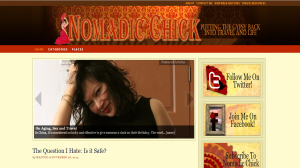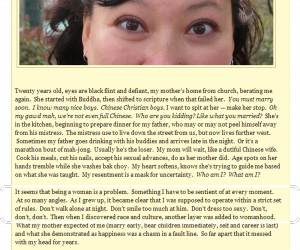
Investing in Identity: Narrative Agency in the Nomadic Chick’s Travel Blog
Rachel Gramer
What: The Nomadic Chick
In 2009, the Nomadic Chick blog began with Jeannie Mark’s decision to “quit” her corporate life in Canada and become a full-time female solo traveler. By 2013, she had ceased to be “nomadic” physically, choosing to settle temporarily in China. And yet, I will argue here, she finds an even more powerful way to inhabit and shape the narrative of transformation through travel that her blog established.
How: Narrative Construction
One of the essential questions I will address is not merely what Mark does in her blog, but rather how she constructs her narrative and, in doing so, creates an agentive virtual identity that enables her to tell her story on her own terms—as an unmarried Southeast Asian woman resisting traditional narrative and cultural positions.
Tracing recent Nomadic Chick blog posts, I will examine the agentive construction of her blog through the lens of psychologist Jens Brockmeier’s (2000) “Autobiographical Time.” Specifically, I will analyze Mark’s linguistic construction of autobiographical time on several levels, including sentence grammar, metaphor, and—most importantly—what Brockmeier (2000) calls the “larger discursive and narrative structures by which we express and shape visions of time,” within which he includes flashbacks, sequencing and embedding (p. 58).
Why: Individual & Cultural Identity
Ultimately, I aim to make a connection between how Mark enacts her narrative agency and why she does so in the blogosphere. Using flashbacks and embedded narratives within posts, she creates a rich sense of self in a virtual environment that celebrates—rather than suppresses—her roles as traveler, writer, and publisher (roles which might be traditionally unavailable to her). In my conclusion, I will position Mark in terms of psychologist Michael G. W. Bamberg’s (1997) third level of positionality, which centers on a speaker in relation to herself to answer the question, who am I? (p. 337). In essence, her blog answers this individual identity question in relation to others, simultaneously re-inventing cultures (both online and offline) while binding herself to them (Brockmeier, 2000, pp. 70-71).
In the Nomadic Chick blog, I argue, Jeannie Mark confronts the self culturally constructed for her and, instead, enacts her own set of lived values. Thus, her most powerful agency is the narrative agency of blogging itself, which allows her to transcend the trope of solo traveler and to highlight the affordances of blogs in constructing—and circulating—autobiographical narratives.
What: The Nomad Rests
Mark began her nomadic venture into the blogosphere in December 2009: “This blog was birthed,” she writes, “to share my honest thoughts on being a mature woman who travels a lot and alone” (“Persona or Presence”). In the beginning, she posted travel tips, lists and weekly “Gypsy Wednesday” posts on topics ranging from travel safety to finance. Then, for more than three years, Mark blogged about her travels, beginning with couch-surfing in Canada and including peak dramatic moments as well as commonplace travel drudgeries. Regardless of the physical place she occupied, Mark blogged within the narrative promise she established from the beginning—building momentum in her tale of transformation through travel.

And then she stopped traveling in China, where she has settled temporarily to teach, but continues to travel and blog to earn material and cultural capital to fund her journey. I discovered her blog shortly after her decision to cease being nomadic, and it is the post that includes this announcement that I offer as both a typical blog post and a complex narrative construction of self.
In “It’s Been 3 Years, Now What?” Mark reflects on her initial decision to leave Canada, offering separate sections that each begin with a photo: posing in front the Taj Mahal on her birthday, holding up a Slurpee at a 7-11 in Vancouver, running with the bulls in San Fermin, and smiling on the beach in Sanya (the southernmost city on the Chinese island). Thus, her post fits the conventions of blogging, combining visual and verbal elements, while also situating it in the genre of travel blog as well.
The subheadings and text, however, tell a different story, introducing multiple facets of her current life, of which travel is only one. Her headings include: “I’m Staying in China (For Now),” “Major Site Redesign,” “I’m Writing a Book!,” and “Where I’m Going Next (For Real)” (“It’s Been 3 Years, Now What?”). While still tied to her main trope of travel, Mark also expands her blog’s scope to present her rationale for a more complex vision of self than the generic constraints of a travel blog require. She is not only planning a trip to Indonesia, but also updating her blog’s design, writing outside the blogosphere, and suspending her nomadic status.
From this moment on, her blog represents a different kind of journey through virtual narrative, one that does not stop moving forward when she ceases to move physically.
How: The Linguistic Construction of Autobiographical Time
As she continues this nuanced version of her original journey, the question becomes how, or through what linguistic devices, does Mark fulfill the narrative of transformation through travel that her blog initially promised?
Brockmeier (2000) wrote that “We use a broad spectrum of linguistic devices to express the temporal dimension of our experiences, memories, intentions, and imaginations. However, in doing so we not only express them but also give them shape” (p. 58). In several blog posts, Mark has shaped her vision of the present by representing her past selves, in a specific order, embedded into posts that also include new information. I will analyze one of these posts in particular, examining how Mark uses multiple linguistic devices to shape her experiences, including sentence grammar and—most importantly—narrative structures such as flashbacks, sequencing, and embedding.
In her post “Asian Women’s Empowerment: Why I’m Honored to be a Speaker,” on July 29, 2013, Mark begins with a title that evokes a specific event, but the opening lines of the post read: “By age six, the world’s mysteries open and offer this pearl. I’m a girl.” Thus, to begin with, the post does not connect to the titled event; instead, Mark immediately plunges readers into a flashback. The paragraphs that follow demonstrate clear gaps in her maturation from a naïve girl of 6 to a single Chinese woman of 38—using embedded micro-narratives of personal flashpoints that occurred along the way.
Mark—who is now 41—consistently switches verb tenses within these flashbacks, using what Brockmeier (2000) referred to as “the time armature of traditional sentence grammar” as “temporal markers” (p. 57). She writes each embedded flashback in the present tense to root readers in these moments: “More rules follow when I’m twelve,” “At fourteen, things turn surreal,” “Twenty years old, eyes are black flint and defiant, my mother’s home from church, berating me again” (“Asian Women’s Empowerment: Why I’m Honored to be a Speaker”).
Then, when she looks back as her current “self,” she switches seamlessly from present to past tense: “It seems that being a woman is a problem,” she writes. “Something I have to be sentient of at every moment. At so many angles. As I grew up, it became clear that I was supposed to operate within a strict set of rules… Then when I discovered race and culture, another layer was added to womanhood” (“Asian Women’s Empowerment: Why I’m Honored to be a Speaker”). In one sense, Mark situates herself today as an adult removed from the young girl she was, but, in another sense, she is still profoundly affected by those experiences.

In these flashbacks, Mark reveals the “rules” she learned from her Chinese mother in particular—from how to dress (always ribbons) to how to act around strangers (ladylike). She traces, too, how she learned shame about being female (one public word from her mother—“bra”) alongside learning shame about being Chinese (receiving taunts from neighborhood kids about “you and your people”). Sequencing flashbacks in chronological time, Mark is able to construct her narrative as part of a progressive transformation into who she is today. And through the gaps, she focuses our attention on the important felt moments without concern for staying true to a strict sense of narrating all events as they occurred in time.
Therefore, while the narrative agency of this post first takes root in childhood reflections, ultimately she examines herself as a culturally constructed being who needed a new platform to mediate the “self” emerging in adulthood. This re-situating of the past can be accomplished only in the construction of autobiographical time—not as it is being lived in actual time. And Mark takes advantage of this affordance in her blog, seeking an alternative sense of self that enables her to, as she elsewhere writes, “shatter those societal labels of spinster, pathetic renter…childless” (“Origins Story: Leaving Everything to Travel”).
After the bulk of this one post, Mark has written herself as a protagonist whose agency lies in her situated awareness of her construction of self in relation to others. And it is not until she writes herself into this position that she reveals the overarching purpose of the post—to explain how she feels after being invited to speak at the Asian Women’s Empowerment (AWE) conference: “…my main motive is to give back what I know. To share my history, but reveal practical tools so others can plant their seeds—watch their dreams grow. …This is such a great honor and I already feel the positive energy from everyone involved…” (“Asian Women’s Empowerment: Why I’m Honored to be a Speaker”). These are the women she will speak to at AWE.
Why: Individual & Cultural Identity Construction
Months later, at the AWE conference, Mark connects her writing to larger cultures of her choosing not only in the blogosphere but also face-to-face in Malaysia. Invited to speak not because of her heritage or past, but because of her present agentive identity, Mark discusses the increasing accessibility of travel for women and the benefits that may seem incidental but become primary: namely, that solo travel teaches “independence and how to make your own choices in the face of societal and family pressures” (“Asian Women’s Empowerment and Public Speaking”).
Throughout these posts (before and after the conference), her agency lies in her construction of a narrative that aligns with, and offers evidence of, a broader cultural philosophy of independence for women—and the circulation of that narrative in a public space where AWE founder and travel blogger Juno Kim could engage with it. Therefore, I will end my analysis by situating Mark in terms of Bamberg’s (1997) third level of positionality, in which the speaker or writer answers the question, who am I? (p. 337). For Mark, the answer includes both self and others, individual in relation to cultural.
A striking example of this kind of individual identity that links her to larger cultures emerges in an August 2013 post, “My Brother Told Me: ‘Get a Real Job,’” in which Mark writes not just about characters in relation to each other (Bamberg’s [1997] first level) or as a speaker in relation to her blogging audience (level two)—but, more importantly, as a speaker in relation to herself (level three) to answer the central question of identity (p. 337).
When she and her brother hit an impasse in conversation—he asserting she should pursue financial security and she asserting in return that such security is elusive for everyone—Mark writes: “So the silence descended. The air heavy with what we can’t say to each other. With my brother, it’s always the implicit meanings” (“My Brother Told Me: ‘Get a Real Job’”). And here she shifts verb tense, as she situates the silence of a conversation (now over) in past tense—but her brother’s disapproval (and her reciprocal irritation) as lingering in the present: “He tailors his life around investments and always having a job that fulfills that ultimate drive: making the uncertain, certain. My dear brother believes there’s a single method that rises above the others on how to live or earn. …That a person’s life is lived by one path, instead of hundreds” (“My Brother Told Me: ‘Get a Real Job’”).
And then, Mark shifts the focus of the post back to herself, back to Bamberg’s (1997) third level of positionality, cementing her solidarity with her original decision even if it satisfies no one but herself:
As a woman, I made the unusual choice to ignore one template and carve out another, and with this choice, it baffles the people I love the most. I wonder if it also scares them. Not because my future hangs in the balance, but because I haven’t followed the prescribed formula of how a single woman should behave…. My ‘serious’ is accumulating experiences, not money. (“My Brother Told Me: ‘Get a Real Job’”)
What she targets in this post—the metaphor of investments—seems key for her as well as for my reading of her, since investment remains a charged term in our 21st century market society, cultural circumstances which saturate the context of this sibling conversation.
In characterizing her current investment, accumulating experiences instead of money, Mark borrows several existing metaphors that situate her as an active agent who first had to “ignore one template” and then “carve out another” (emphasis added). However, the metaphor of investment seems most robust and appears again in her post titled “Persona or Presence,” in which she writes, “I always ponder investment. How much do I invest in my Internet ‘face’ over how often I step away from the computer to round out my life? Is the blog me or am I the blog?” Thus, Mark situates her blog as an identity investment different from the conventional investments of womanhood and adulthood thrust upon her.
In the end, the agentive identity Mark constructs has real material consequences not only for her, but also for other women seeking to enact similar notions of independence from cultural constraints. In her blog, Mark navigates, as Brockmeier (2000) argued we all do, the “cultural moorings of individual identity construction” (p. 70). Her narrative serves as a model seeking to empower other women in male-dominated societies to share their stories publicly as a way to combat the limited paths that are still offered as acceptable for Southeast Asian women in the 21st century: “Be beautiful enough, yield, get married period” (“Asian Women’s Empowerment: Why I’m Honored to be a Speaker”). Mark asserts her narrative agency by encouraging other women to exercise their ability to construct their own narratives in spite of these powerful cultural constraints.
In doing so, she learns that she is not alone: “I chose the most unconventional life possible,” she writes. “What I’ve figured out from childhood, to adolescence and finally to full adulthood is that my tale is dusty and ancient. That so many other women lived or [are] currently living the same narrative” (“Asian Women’s Empowerment: Why I’m Honored to be a Speaker”).
While connecting her individual narrative to multiple cultural narratives—including her family, patriarchal Chinese and other southeast Asian cultures, the gendered space of physical solo travel and the virtual space of the blogosphere—Mark simultaneously re-invents these cultural spaces as she binds herself to a larger community of women seeking similar freedoms (Brockmeier, 2000, p. 70). Her blog enables her not only to record changes in her life (both geographical and chronological), but also to create a stable site of narrative construction on her own terms—and share it instantly, in a click, with a global community that might have otherwise remained invisible to her.
next


